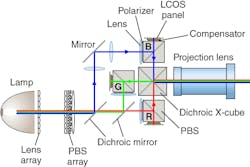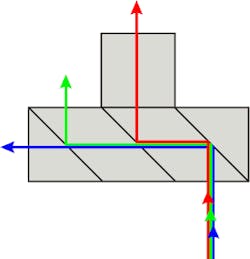IMAGING & DISPLAYS: Complex monolithic optics bring ruggedized solutions to digital cinema
ALAN C. GRAHAM AND NING CHAN
For the majority of the last 100 years, the cinema viewing experience has been primarily dependent on the quality of the film stock. Although the selection of film gauge (8, 16, 32, and 65 mm) largely determines the quality of the projected image, advances in film emulsion and grain structure have improved the quality of the projected image for all film gauges. In addition, the cinematographer has a wide variety of tools at his/her disposal that impact the quality of the image including color sensitivity, depth of field, and lighting. However, once the film is printed, the projector manufacturer and the projectionist have only to ensure that the projected image remains in focus.
The advent of digital cinema has changed that relationship; today, the cinematographer, the digital projector manufacturer, and the projectionist must work together to produce the content, provide the means to project the content, and ensure the content is projected—something that not only requires focus, but now includes brightness, contrast, color saturation, and multi-image alignment accuracy. To duplicate the viewing experience of film, digital projector manufactures require physically separate formations of highly complex optomechanical assemblies that must be aligned and maintained over a broad temperature range, on the order of 10°C to 200°C. This harsh environment inside the projector can significantly degrade performance, requiring frequent realignment and downtime.
Complex monolithic optic (CMO) design is an optical solution that replaces these discrete, physically separate formations of highly complex optomechanical assemblies with an integrated monolithic optical assembly. This CMO design improves performance, minimizes aging degradation, and can result in a user experience that more closely duplicates the film experience.
The microdisplay challenge
Digital cinema projectors utilize three monochromatic image panels (red, green, and blue) that are combined into a single full-color image and magnified 500X or more and projected up to 30 m. Digital light processing (DLP) imaging panels developed by Texas Instruments (Dallas, TX) and liquid crystal on silicon (LCoS) image panels developed by Sony (Tokyo, Japan) are the only current imaging technologies with sufficient pixel resolution to meet the resolution and magnification required for theatrical projection.
The combination of the red, green, and blue image panels requires each complementary set of pixels to be aligned (that is, the bottom right-hand corner pixel of the red panel must be aligned to the bottom right-hand corner pixels of the green and blue panels). The human eye, which has an angular resolution down to 1/60°, is sensitive to panel misalignment, so precise superposition of the pixels is critically important. At a distance of 10 m (a typical minimum viewing distance in a movie theater), the spatial resolution of the eye is 3 mm. This requires each pixel set to be aligned to within 6 µm throughout the entire image. Today, combinations of precisely aligned formations of highly complex optomechanical assemblies are required to create and maintain this degree of alignment over the temporal and environmental operating conditions.
DLP image technology
Digital-light-processing image panels are conceptually simple arrays of reflective light switches (see Fig. 1). The reflective light switch is a binary device (on/off), so graduated intensities (grayscale) are achieved by rapid oscillation between the on and off state; the relative duration of a pixel's "on-state" to "off-state" dictates the brightness. An eight-bit grayscale encoding scheme will produce 256 unique shades of gray for each primary color, or 2563 (16.7 million) different color combinations.
Light from the projection lamp is separated into the three primary colors and steered to each image panel by dichroic filter coatings on the surfaces of specially designed prisms, and total internal reflection (TIR) interfaces. After illumination, the dichroic coatings and TIR interfaces recombine the three monochromatic images into a single color image. The TIR interface necessary to direct the "on-state" light to the projection lens requires an air gap between prism surfaces, which in turn requires an optomechanical structure to align and hold the separate assemblies.
LCoS image technology
Liquid-crystal-on-silicon image panels modulate the intensity of each pixel by aligning the panel between crossed polarizers and managing the polarization state of the light (see Fig. 2). A generic system of the type first developed by IBM and Nikon uses three polarization beamsplitters (PBS) surrounding an X-cube. Prepolarizers and lenses are aligned between the light source and panel to ensure clean and telecentric input polarization for each panel. Skew-ray depolarization is corrected by quarter-wave plates aligned between the panels and PBSs, with the fast axis perpendicular to the plane of incidence. Each PBS directs light from the "on-state" pixels to the X-cube and light from the "off-state" pixels back to the light source. To improve X-cube throughput, most architectures use half-wave plates to rotate the plane of polarization between the X-cube and the red and blue PBSs. To improve contrast, Sony's SXRD solution includes additional PBSs between the image panels and the X-cube to minimize skew-ray depolarization.The multiple dichroic filters, turning mirrors, prisms, and polarization optics used to create a combined image requires high-precision optomechanical assemblies that must maintain alignment, and not introduce mechanical stress to the glass during shipping, storage, and operation. The long-term alignment drift and inherent hysteresis in an optomechanical assembly can exceed the precision required to align and maintain the images produced by each color. So the optomechanical assembly not only must be aligned in the factory prior to shipment, but can also require initial alignment in the field and ongoing maintenance to ensure image fidelity is maintained. Similar challenges in the field of displacement interferometry have been solved through the use of CMO design, where multiple-channel displacement interferometers have successfully replaced optomechanical configurations of discrete optics.
Complex monolithic optics
Though optical assemblies utilizing precision mounting hardware can have a high degree of accuracy and alignment precision that is sufficient to achieve the panel-to-panel registration requirements discussed previously, the probability of failure in that optical system is proportional to the complexity of the system. In particular, the magnitude of the alignment error in an optical system with a large number of optical-to-mechanical interfaces, and/or a large number of beam-to-optical-surface interactions such as those previously described, is significantly higher than a comparable optical system with small numbers of interfaces and interactions.
This principle is easily illustrated with a simple lens system. Air-spaced lens doublets require an optomechanical assembly with precision-machined surfaces that hold two discrete lenses. Though the assembly can be expensive to manufacture, the two lenses can be precisely aligned relative to each other with the appropriate selection of mounting hardware. However, the integrated assembly will be subject to long-term alignment drift requiring periodic realignment and cleaning.
Integration of optical functionality without the use of mechanical structures is a familiar concept in these types of multielement lens systems. An environmentally robust monolithic (usually epoxied) doublet cannot be aligned in the lab, so the alignment tolerances must be precisely controlled during the fabrication process. This is typically done using external and reusable assembly tooling that allows all alignment tolerances to be built into the optical components. This manufacturing paradigm is much less expensive to manufacture and enables the lens doublet to maintain its alignment over a wide variety of operational environments, eliminating the need for periodic laboratory alignment.
Design of complex monolithic optics is a planar-optic analog to the monolithic integration of curved optics. Without reliance on numerous mechanical assemblies, CMO design integrates discrete optical functionalities such as chromatic, power, and polarization separation and combination, beam steering, and phase control. These CMOs, which can also incorporate curved optical surfaces, virtually eliminate alignment stability randomness by incorporating all alignment tolerances in the manufacturing process.
CMO design in digital cinema
Chromatic separation and combination are important optical functionalities in digital cinema projectors. Dichroic filters are primarily used to separate the high-intensity xenon arc-lamp into the primary colors (red, blue, and green), and after the pictorial information is encoded in each color channel, to recombine the separate colors into a single multicolor image. The large number of optical-to-mechanical interfaces and beam-to-surface interactions required for chromatic separation and combination in the DLP and LCoS projector designs puts stringent requirements on the optomechanical alignment tolerances. In contrast, CMO designs can eliminate many of the optomechanical interfaces, and reduce the beam-to-surface interactions. Rhomboid architectures are a simple CMO alternative to optomechanical color separation and combination assemblies described above that require only one optical-to-mechanical interface, and four beam-to-surface interactions (an input aperture and three output apertures—one for each color; see Fig. 3). In addition, the rhomboid architecture balances the optical path length for each color, eliminating the need for additional lenses to compensate for glass path imbalance, a substantial improvement over traditional architectures.Digital cinema projectors have a number of other optical functionality requirements that can be integrated into CMO design, including beam steering and polarization management. Conceptually, the remaining optical functionalities can be integrated into the CMO design without a significant increase in the number of optomechanical interfaces or beam-to-surface interactions. These types of CMO designs are now being evaluated for integration into digital projection systems, which will enable digital projectors to be smaller, lighter, more robust, and more reliable.
Alan C. Graham is business development manager and Ning Chan is an optical engineer in the Nano Positioning Metrology Division at Agilent Precision Optics, 5301 Stevens Creek Blvd., P.O. Box 58059, M/S 52U/04, Santa Clara, CA 95052-8059; email: [email protected]; www.agilent.com.


